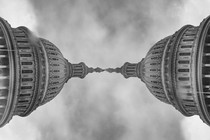Fill the Swamp?
5 min read
As the 2016 presidential election drew to an end, Donald Trump began using a new slogan: “Drain the swamp.” It was a neat encapsulation of his critique of his Democratic opponent, Hillary Clinton, and of the country’s governing establishment of both parties, which he painted as corrupt, cozy, and self-dealing.
These days, the catchphrase has begun to vanish from his repertoire. Last month, The Washington Post calculated that Trump had used it “just 59 times on Truth Social, his social media site, in the past two years—fewer times than he wrote about it on Twitter in October 2016 alone.” The shift isn’t just semantic, either. Trump’s staffing decisions, his transition design, and his own behavior show that he is uninterested in even keeping up appearances this time. Trump himself will never say it, but the credo of his second term is coming into focus: Fill the swamp.
The best evidence is who Trump is hiring for top positions. Susie Wiles, who managed Trump’s 2024 campaign, was a registered lobbyist until she was named White House chief of staff after the election. She joined Ballard Partners, a Florida-based firm, in 2011, lobbying for a variety of clients. In 2018, Politico Magazine called the firm’s founder, Brian Ballard, “the most powerful lobbyist in Trump’s Washington.” (Ballard recently told The New York Times that Wiles’s work for his firm was mostly strategy and messaging rather than traditional lobbying.)
Ballard Partners’ footprint extends past the West Wing. Pam Bondi, Trump’s new nominee for attorney general, also worked at the firm after a stint as attorney general of Florida. Her clients there included the Qatari government, Amazon, and Uber. Sean Duffy, Trump’s pick for transportation secretary, worked as a lobbyist at another firm. In August, Trump told the podcaster Theo Von, “You have to stop listening to lobbyists.” That should start with a very easy step: Don’t hire lobbyists to staff your own administration.
But it’s not just lobbyists. Trump is also picking many people who come straight from industries that the government regulates or does business with. As the journalist David Dayen put it, Trump’s transition team and early appointments are full of people “better known for paying the lobbyists than being them.” That list includes Commerce Secretary–designate Howard Lutnick, the CEO of the financial firm Cantor Fitzgerald; Linda McMahon, the former head of World Wrestling Entertainment and now the nominee to lead the Education Department; and the Treasury nominee Scott Bessent, a hedge-fund mogul.
Even more glaring is Elon Musk, the richest man in the world and a major government contractor, who has been acting as a sort of “co-president” or “first buddy” to Trump. He’s been appointed to co-lead an unaccountable (though probably toothless) committee to review government spending and increase efficiency, from which perch he could seek to punish competitors or enrich himself.
The Trump team is being created in the image of its leader. His first term was, despite the campaign slogan, extremely boggy. He declined to release tax records, in contrast with previous presidents. He declined to divest himself from his business or to keep it in anything resembling a blind trust. Instead, he operated a luxury hotel down the street from the White House, which became a great place to spend money and be seen for anyone who wanted to ingratiate themselves with Trump, including foreign-government representatives. Trump spent four years forcing the Secret Service to stay at his properties, charging exorbitant rates and misleading the public about it. The lobbying industry boomed—at least for the hundreds of former lobbyists who weren’t already working in the administration.
Today, the Trump hotel is gone but almost everything else is worse. During Trump’s first transition, he felt obliged to at least go through the motions of distancing himself from his business, even though the plan was a sham. He hasn’t bothered to do anything like that this time. He now has a major stake in Truth Social, a media company whose stock fluctuates in direct relation to his political fortunes and actions. His sons are involved in cryptocurrency ventures that he could boost. In 2017, he pledged that his business would not make any new foreign deals while he was in office, but it made many while he was out, and he has made no new commitment this time. His son-in-law Jared Kushner is said to not be joining the White House for Trump’s second term, but he’s been involved in the transition. Kushner has spent the past four years making major deals overseas.
Trump also dragged his feet on agreeing to rules for his transition; he finally struck a deal on November 26, but it’s well short of the standards set by past agreements. (Trump has also not agreed to the usual FBI background checks for nominees and appointees.) In particular, the arrangement avoids government help with cybersecurity, office space, and funding. The campaign offered a positive spin on this in a statement: “The Transition will not utilize taxpayer funding for costs related to the transition, which is consistent with President Trump’s commitment to save taxpayers’ hard-earned money.” In effect, though, it means that what the transition does and who funds it—with the influence that might come with that—are hidden from taxpayers. What citizens save in dollars, they lose in basic accountability.
Even during the 2016 campaign, Trump used to tell crowds that he was ambivalent about “Drain the swamp” as a mantra. “This is a phrase—I tell you, I didn’t like it,” he told a crowd in Raleigh, North Carolina, on the eve of the election. “I thought it was hokey.” He’s clearly now decided that the concept of draining the swamp is hokey too.



